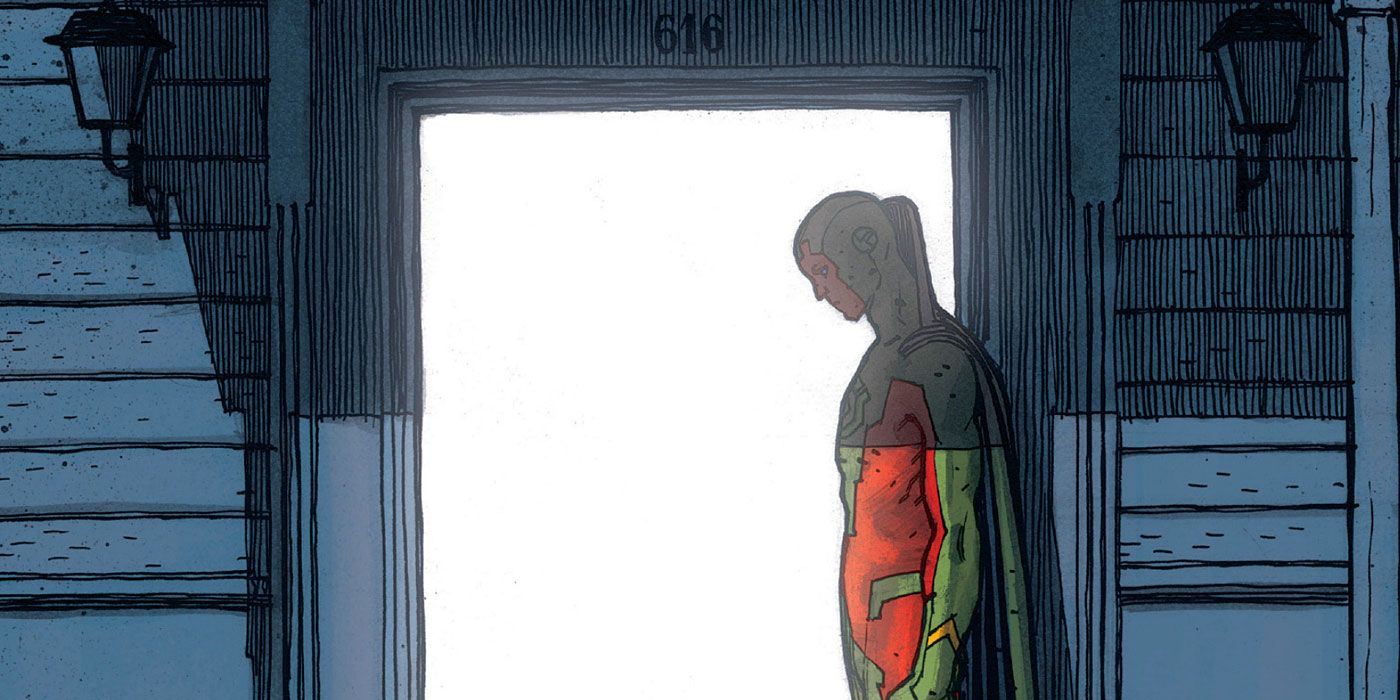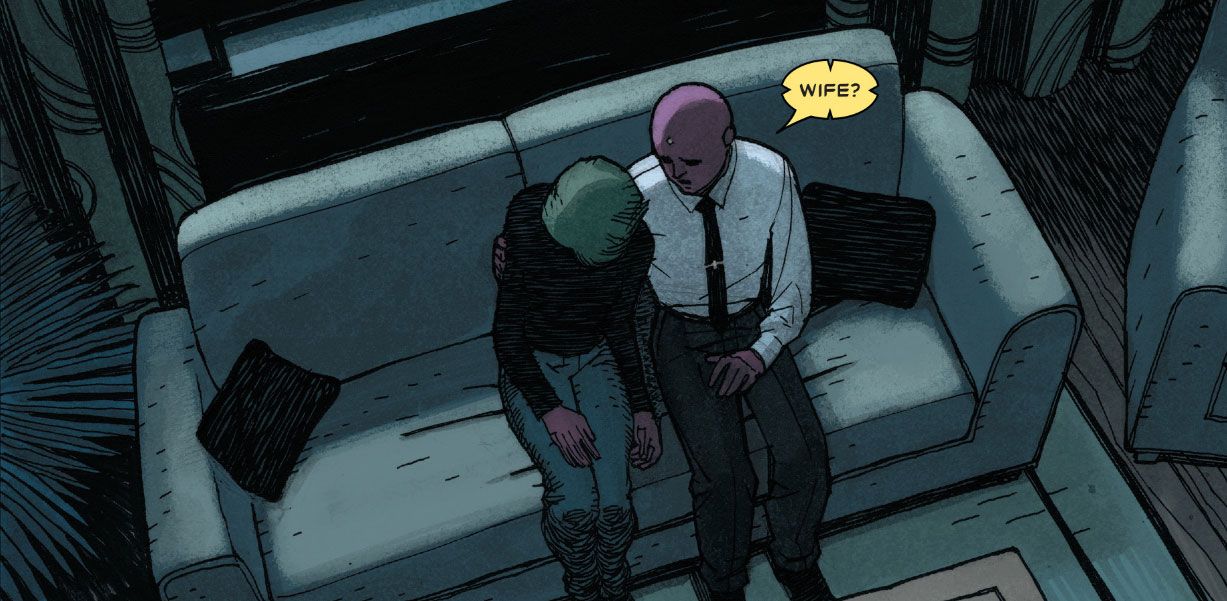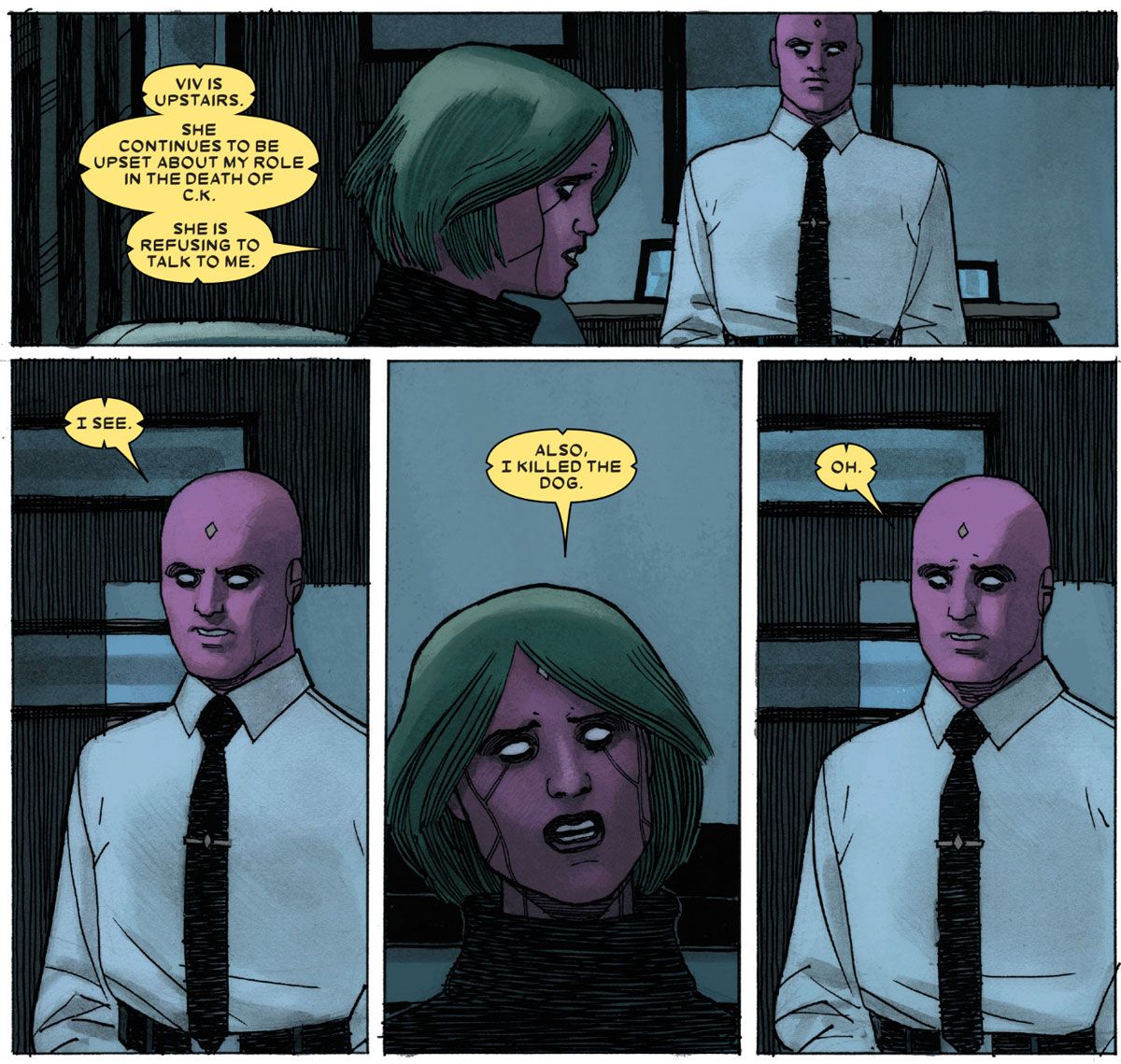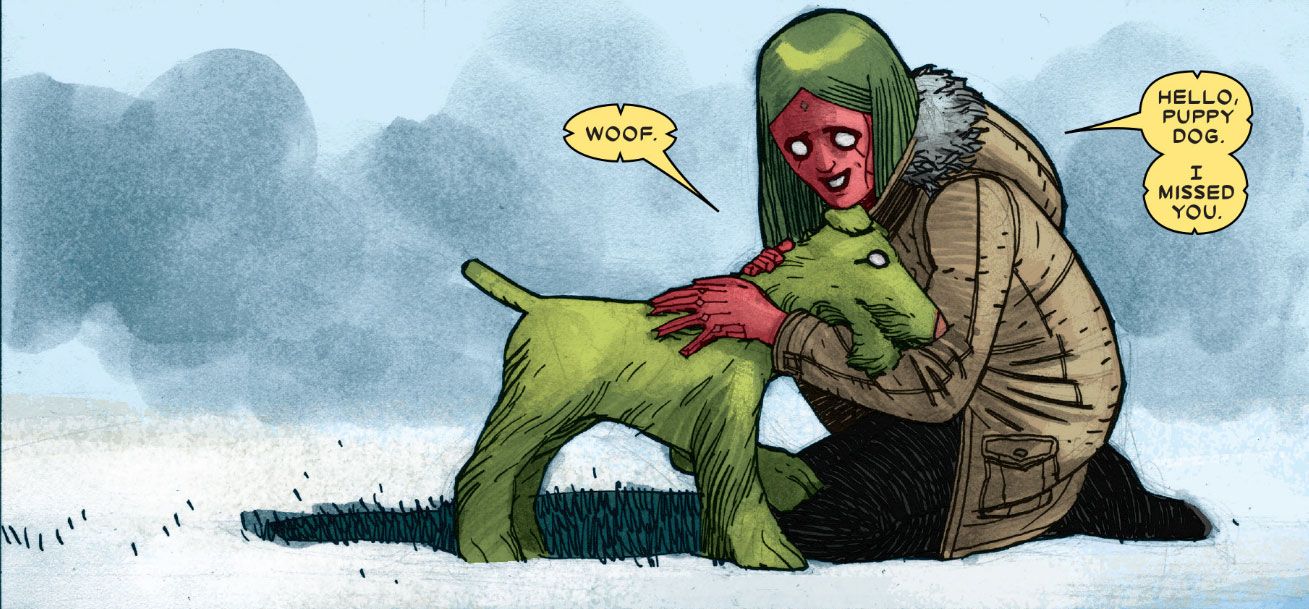SPOILER WARNING: The following interview contains spoilers for "The Vision" #12, on sale now.
With “Vision” #12, a noble American experiment comes to a fiery close, a nuclear family shred down to the atoms.
“I didn’t know 100% how it was going to end,” writer Tom King told CBR of his loose outline for what became a 12-part series. What he did have was a vision. He likens that vague image in his mind to an Alan Davis cover from “The Fall of the Mutants” crossover. It's perhaps not all that shocking a composition today, a heap of vanquished heroes on the field of battle, but it struck a particular chord in 1988 to see Wolverine, Colossus, Rogue, Warlock and so many more lay battered and discarded, like yesterday’s toy soldiers.
Followers of King’s Twitter account will note that he does some of his most out-of-the-box plotting with a pile of action figures on the living room floor.
“I had an image in my head of Vision and Virginia floating in the sky above it all,” he says. “One last confrontation over what just happened. Whatever that was.”
RELATED: Here’s How Vision’s Final Issue Sets Up Viv To Join The Champions
The specifics of the final battle would come in time, the story shaped, in part, by King’s transition to an exclusive deal with DC Comics early in the "Vision’s" run. It’s telling, though not especially suprising, that King’s mental picture for the finale centered on a moment of quiet, a survey of the wreckage in the very eye of the storm. The writer likes to joke that he so often saddles artist Gabriel Hernandez Walta with scene after scene of pink synthoids sitting in silence. Surely, Walta must suffer through this like some child in summer school watching out the window as his peers cartwheel through thrilling action sequences on other, less Vision-y books.
On the contrary, Walta actually delights in the change of pace.
“What I really like in any story is to have some contrast between quiet and action scenes,” the artist told us. “That way, when you finally release the tension, the effect is much more powerful. Sometimes I feel that there is too much ‘noise’ in comic-books. There are moments when you need to be subtle and let the characters act. Quiet scenes are perfect for this.”
“I always enjoyed drawing the interactions between all the members of the synthezoid family, trying to give each scene the right amount of emotion, without being melodramatic,” Walta says. “Issue #10, for example, had some truly heartbreaking moments and as a storyteller those were, simultaneously, the more difficult and the more rewarding challenges.”
It was a weird pitch, King is first to admit. “Robots in the suburbs, but not played for laughs? When I first started on ‘Vision,’ ‘Omega Men’ had just been canceled. I just assumed this would also be canceled. I didn’t think anyone would read it, so I didn’t have a big plan outside of the first twelve.”
“'Vision' was the big game-changer in my career. Specifically, ‘Vision’ #1. I was very much a struggling writer. I was writing half of ‘Grayson.’ ‘Omega Men’ had been cancelled. ‘Vision’ #1 came out in the midst of a ton of other #1’s, and it didn’t sell like gangbusters. But it hit a nerve with critics and fans in such a way that people started looking at my other work and saw that I could write. I was no longer a guy trying to write, I was an actual writer. I got ‘Batman’ on the strength of that issue. It’s much more complicated than that, obviously, but I feel that it comes from that.”
Had he not been offered an exclusive contract with DC Comics and had instead been given the nod to continue past twelve issues, King says he would have sent Vision off to outer space. He points to the Jim Starlin catalogue of characters and themes as a particularly enticing sandbox. Once he knew that that thirteenth issue wasn’t in the cards, however, the writer made necessary adjustments to settle Vision’s affairs more tidily, if not so happily ever after.
King’s image of the final confronation gradually shifted from the skies over a literal battlefield to the Vision family’s home, a house Walta lovingly mapped and modeled. That setting, based largley on photos of King’s former neighborhood in Arlington, VA, became as much a character as Vision, Virginia, Viv and Vin. Seeing Walta’s attention to detail in that first issue -- an exactitude King compares to the realization of Moore and Gibbons’ “Watchmen” corner -- the writer knew how central that home, with its hovering mailbox and Floating Water Vase of Zenn-La, ought to be.
Thereafter, King, Walta, Bellaire and Cowles offered an American tragedy, posing questions of prejudice, post-humanism, fear and family. In the wake, a certain sense of finality, but little in the way of concrete answers. That’s very much by design.
“One of the things about Tom's scripts that I love the most is that he doesn't want to explain everything,” says Walta. “He leaves room to the reader to make his or her own conclusions. That doesn't mean that he hasn't got a plan, or that he isn't trying to tell you something, but in the end, he is not trying to tell you what to think.”
“In that sense,” Walta continues, “the ‘big question’ that I see more often reflected in the book is that there are no easy answers to anything that really matters. Many times you won't know what is clearly ‘right’ or ‘wrong,’ but [readers] will have to make a decision.”
“‘Vision’ is not meant to be a book with easy answers,” stresses King, “It’s meant to be an interaction with the fans. There’s no grand moral. No one at the end to claim that this is what it’s all about. I purposesly left any of that out.”
King would much rather reflect on his collaborators’ lasting contribution than any futurist koens or impossible equations. “Gabriel Walta is a modern master and his work on ‘Vision’ will be remembered for a long, long time.”
As for what they’ll miss now that Vision’s suburban experiment has reached an end, King expressed particular pride in the letters pages, and interacting with an engaged and thoughtful reader base. Of course, both lamented the end of their collaboration, at least for now.
“I did not make ‘Vision’,” says King. “I was part of a team that made ‘Vision.’”
“It was clear from the very first moment that there was a special synergy between us and I'm looking forward to getting involved in another project with all of them. The great thing about working with people so talented as Jordie and Clayton is that they always managed to surprise us and always took what Tom and myself had previously done to the next level. A ‘Vision’ issue didn't look like a Vision issue until the color art and the lettering was finished.”
“That said,” adds Walta, “I really hope I won't be asked to ‘kill’ more pets soon!”




